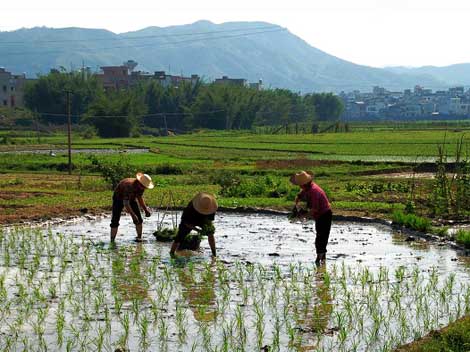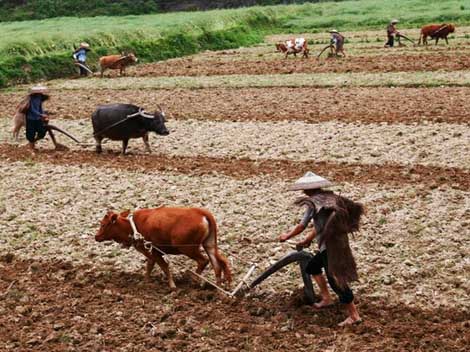The 24 solar terms are special terms created by ancient working people of China to reflect the changes of weather, climate and natural phenomena. The terms are closely related to agricultural production and every aspect of daily life, including clothing, food, housing and transportation etc.

Thousands of years ago, the ancestors of the Chinese people began to observe the movement of the sun. Way back in the Spring and Autumn Period, earth sundials (a pole erected on a level surface) were used to measure the length of the shadow under the sun at noon to determine the four solar terms of winter solstice, summer solstice, vernal equinox and autumnal equinox.
During the course of a year, the day when the shadow of the earth sundial is the shortest is the summer solstice; the day when the shadow is the longest is the winter solstice; the day when the shadow is of medium length is either the vernal equinox or the autumnal equinox. The solar terms were documented in the ancient book of the Spring and Autumn Period -The Classic of History.

Later, the length of time the sun takes to complete a full circle of angle changes was defined as a tropical year based on the relations between the solar, lunar motions and the weather, the growth of plants and animals and other natural phenomena. The angles were evenly divided into 24 segments, with 15 degrees in each segment. The 24 segments were the 24 solar terms. The philosophical classic from the Western Han Dynasty - Huainanzi (or "The Philosophers of Huainan") has a complete record of the 24 solar terms.
"Start of Spring": around February 4th of the solar calendar, indicating the beginning of spring.
"Rain Water": around February 18th of the solar calendar, indicating the gradual increase of rainfalls.
"Awakening of Insects": around March 5th of the solar calendar, indicating a relatively fast temperature rise and possible spring thunders.
"Vernal Equinox": around March 20th of the solar calendar, indicating the equal length of day and night.
"Clear and Bright": around April 5th of the solar calendar, indicating clear skies, fresh air, warm weather and lush plants.
"Grain Rain": around April 20th of the solar calendar, indicating the increase of rainfalls, which is good for grain crops.
"Start of Summer": around May 5th of the solar calendar, indicating the beginning of summer.
"Grain Full": around May 21st of the solar calendar, indicating that the seeds of summer crops are getting plump but not ripe yet.
"Grain in Ear": around June 6th of the solar calendar, indicating the ripening of wheat crops and the beginning of a busy farming season.
"Summer Solstice": around June 21st of the solar calendar, indicating the extreme of summer in astronomical terms.
"Minor Heat": around July 7th of the solar calendar, indicating that the hottest days are yet to come.
"Major Heat": around July 23rd of the solar calendar, indicating the hottest time of the year.
"Start of Autumn": around August 7th of the solar calendar, indicating the beginning of autumn.
"Limit of Heat": around August 23rd of the solar calendar, indicating that summer is coming to an end.
"White Dew": around September 7th of the solar calendar, indicating that the temperature begins to fall, the weather is getting cold and there are dewdrops on grass and trees in the morning.
"Autumnal Equinox": around September 23rd of the solar calendar, indicating the equal length of day and night.
"Cold Dew": around October 8th of the solar calendar, indicating lower temperature, dew in the air and cold feeling.
"Frost Descent": around October 23rd of the solar calendar, indicating the appearance of frost.
"Start of Winter": around November 7th of the solar calendar, indicating the beginning of winter.
"Minor Snow": around November 22nd of the solar calendar, indicating the beginning of light snowfalls.
"Major Snow": around December 7th of the solar calendar, indicating the beginning of heavy snowfalls.
"Winter Solstice": around December 22nd of the solar calendar, indicating the extreme of winter in astronomical terms.
"Minor Cold": around January 5th of the solar calendar, indicating that the weather is getting colder, but the coldest days are yet to come.
"Major Cold": around January 20th of the solar calendar, indicating the coldest time of the year.





